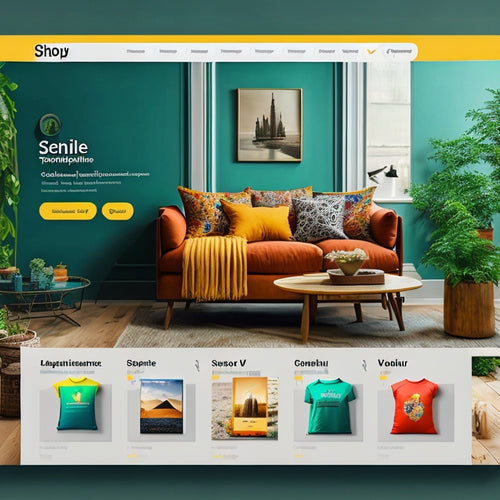
Crafting Digital Products for Ecommerce Success
Share
You're already sitting on a goldmine of opportunity in the ecommerce market, where digital products can be crafted to drive massive revenue and growth. To get started, identify profitable digital products by conducting thorough market research, evaluating profit margins, and understanding your target audience's needs. Define your unique selling proposition, develop engaging course content, and design interactive learning experiences. Build effective sales funnels, price your product strategically, and launch targeted marketing campaigns. Finally, track your performance metrics, analyze data, and optimize your strategy. By mastering these steps, you'll be well on your way to ecommerce success - and that's just the beginning.
Key Takeaways
• Conduct thorough market research to identify profitable digital products that fill market gaps and meet customer needs.
• Develop a unique selling proposition (USP) that differentiates your product from competitors and resonates with your target audience.
• Create high-quality, engaging course content that drives business results and stays ahead of industry trends in the digital landscape.
• Design interactive learning experiences that cater to diverse learning styles, increase engagement, and foster a sense of community.
• Optimize your sales funnel and pricing strategy to maximize revenue, utilizing data-driven decision making and performance metric analysis.
Identifying Profitable Digital Products
To capitalize on the lucrative ecommerce market, you need to pinpoint digital products that resonate with your target audience and generate substantial revenue. This requires thorough product research to identify gaps in the market and opportunities to innovate.
Conduct a competitive analysis to understand what similar products are already out there, and how you can differentiate yours. Analyze their strengths, weaknesses, and customer reviews to refine your product concept.
When evaluating product ideas, consider the profit margin and pricing strategy. Calculate the cost of production, marketing, and distribution to determine a competitive price point that guarantees a healthy profit margin. A high-profit margin gives you room to adjust prices, invest in marketing, and respond to changes in the market.
Understanding Target Audience Needs
You must delve into the psyche of your target audience to uncover their pain points, motivations, and behaviors that drive their purchasing decisions. This understanding is vital in crafting digital products that meet their needs and ultimately drive ecommerce success. To achieve this, you'll need to gather data through user feedback, market research, and trend analysis. This data will help you create customer personas, which are essential in guiding your product development process.
Here's a breakdown of the key characteristics to contemplate when creating customer personas:
| Characteristic | Description |
|---|---|
| Demographics | Age, gender, occupation, income level |
| Pain Points | Frustrations, challenges, and problems they face |
| Goals | What they want to achieve with your product |
| Behaviors | How they interact with similar products or services |
| Preferences | What features, design, and functionality they prefer |
Defining Unique Selling Proposition
Now that you've got a solid grasp on your target audience's needs, it's time to pinpoint what sets your digital product apart from the competition.
You need to identify your unique value proposition (UVP) - the unique benefits that only your product can offer. By doing so, you'll be able to craft a compelling message that resonates with your target audience and drives sales.
What Sets You Apart
By identifying what sets your digital product apart from the competition, you can craft a compelling unique selling proposition (USP) that drives sales and customer loyalty. To do this, focus on brand differentiation and market positioning.
What makes your product unique? What problem does it solve that others don't? What features or benefits does it offer that others can't?
Answering these questions will help you uncover your competitive advantage and unique offerings. This, in turn, will enable you to create a USP that resonates with your target audience and sets you apart from the competition.
Remember, your USP isn't just a marketing slogan - it's a promise to your customers that you're committed to delivering on. So, take the time to get it right. Conduct market research, analyze your competition, and gather feedback from your customers.
The result will be a USP that drives sales, boosts customer loyalty, and sets you up for long-term ecommerce success.
Unique Value Proposition
Crafting a unique value proposition involves identifying the specific benefits that your digital product delivers to customers, and then communicating those benefits in a way that resonates with your target audience. It's about understanding what sets you apart from the competition and articulating that difference in a compelling way. To develop a strong unique value proposition, you need to conduct market research to understand your customers' needs and pain points. You also need to analyze your competitors to identify gaps in the market that your product can fill.
Here are some key considerations to keep in mind when crafting your unique value proposition:
| Aspect | Question | Example |
|---|---|---|
| Brand Positioning | What makes my brand unique? | Sustainable fashion brand |
| Competitive Analysis | How do I differ from competitors? | Patented fabric technology |
| Differentiation Tactics | What sets my product apart? | 30-day money-back guarantee |
| Customer Benefits | What value do I deliver to customers? | High-quality, eco-friendly clothing |
Developing Engaging Course Content
When crafting digital products for ecommerce success, you'll want to focus on developing engaging course content that resonates with your target audience.
To achieve this, you'll need to identify learnable skill sets that align with your unique selling proposition and create a course content strategy that effectively communicates value to your customers.
Learnable Skill Sets
You'll need to master a range of learnable skill sets to develop engaging course content that resonates with your target audience and drives ecommerce success. In today's digital landscape, staying ahead of industry trends is essential.
Focus on developing skills that are in high demand, such as content creation, instructional design, and digital marketing. Staying up-to-date with the latest industry trends will enable you to create content that meets the evolving needs of your target audience.
To accelerate your skill development, leverage online resources such as webinars, tutorials, and online courses. Consider certification options like HubSpot's Content Marketing certification or Google's Analytics Academy to demonstrate your expertise.
These certifications can help you stand out in a competitive market and increase your credibility with potential customers. By investing in your skill development, you'll be able to create high-quality course content that drives ecommerce success.
With the right skills and knowledge, you'll be well on your way to crafting digital products that resonate with your target audience and drive business results.
Course Content Strategy
By pinpointing your target audience's pain points and understanding their goals, you can develop a course content strategy that speaks directly to their needs and drives ecommerce success.
To create a winning course content strategy, you'll need to focus on two key areas: content delivery and engagement strategies. Here's a breakdown of what this looks like in practice:
| Content Delivery | Engagement Strategies |
|---|---|
| Microlearning: Break down complex topics into bite-sized chunks | Gamification: Incorporate rewards and challenges to boost motivation |
| Storytelling: Use narratives to make complex concepts more relatable | Interactive Quizzes: Encourage active learning and feedback |
| Visual Aids: Use videos, images, and diagrams to aid understanding | Discussion Forums: Foster community and collaboration |
| Real-World Examples: Use case studies and scenarios to illustrate key concepts | Live Sessions: Offer Q&A and coaching opportunities |
Designing Interactive Learning Experiences
Developing interactive learning experiences that drive engagement and conversion requires intentionally crafting digital products that cater to diverse learning styles and preferences. To achieve this, you'll need to incorporate interactive modules that encourage active participation and foster a sense of community.
This can include gamification elements, quizzes, and discussion forums that keep learners invested in the content. By doing so, you'll increase user engagement, which is critical for conversion. In fact, studies have shown that interactive content can boost engagement by up to 50%.
Additionally, incorporating real-life scenarios and case studies can help learners apply theoretical concepts to practical problems, further enhancing the learning experience. By designing interactive learning experiences that cater to diverse learning styles, you'll be able to increase learner satisfaction, reduce dropout rates, and ultimately drive conversion.
Creating Valuable Bonus Materials
To further amplify the impact of your digital product, craft bonus materials that complement your interactive learning experiences, providing learners with a complete toolkit to achieve their goals. This is where you get to think outside the box and create exclusive, downloadable resources that learners can't find anywhere else. By doing so, you're not only adding value to your product but also increasing learner engagement and satisfaction.
Offering personalized, bonus content can also help you stand out from the competition. This could be in the form of customized templates, worksheets, or even one-on-one coaching sessions. The key is to create materials that are tailored to your learners' specific needs and pain points.
Building Effective Sales Funnels
You'll need a well-organized sales funnel to convert interested prospects into paying customers, and that starts with strategically guiding them through a series of targeted touchpoints. This is where sales funnel optimization comes in – by analyzing and refining each step, you can greatly enhance conversion rates.
To get started, map out your customer's journey, identifying pain points and opportunities to nurture leads.
- Identify and eliminate friction points that cause drop-offs
- Use persuasive messaging and social proof to build trust and credibility
- Optimize your calls-to-action (CTAs) for maximum visibility and appeal
Pricing Strategies for Success
By setting the right price for your digital product, you can maximize revenue, attract ideal customers, and gain a competitive edge in the ecommerce market. To achieve this, adopting a data-driven pricing strategy that considers your target audience, competition, and product value is key.
One approach is dynamic pricing, which involves adjusting prices in real-time based on demand and supply. This can help you capitalize on peak sales periods and stay competitive. Another strategy is to offer promotional discounts to first-time buyers or loyalty rewards to repeat customers.
Conducting a thorough competitive analysis can also help you identify gaps in the market and opportunities to differentiate your product. Understanding pricing psychology is vital too, as it can influence consumer behavior and purchasing decisions. For instance, pricing your product at $9.99 instead of $10 can make it more appealing to customers.
Launching and Marketing Courses
With your pricing strategy in place, it's time to turn your attention to launching and marketing courses that drive engagement, conversion, and ultimately, revenue growth. You've put in the effort to create a valuable digital product, now it's time to get it in front of your target audience.
To maximize course promotion, focus on developing marketing strategies that resonate with your audience.
-
Leverage email marketing campaigns to build anticipation and excitement around your course launch.
-
Utilize social media platforms to share engaging content, sneak peeks, and behind-the-scenes insights into your course creation process.
-
Collaborate with influencers or industry thought leaders to expand your reach and credibility.
Measuring and Optimizing Performance
As you launch your digital product, you'll want to track its performance to guarantee it's meeting your ecommerce goals.
To do this, you'll need to identify and analyze key performance metrics that inform data-driven decisions.
Data-Driven Decision Making
You need to track key performance indicators (KPIs) like conversion rates, bounce rates, and average order value to make data-driven decisions that boost your ecommerce product's performance and drive business growth. By monitoring these metrics, you'll gain valuable insights into your customers' behavior, identify areas for improvement, and optimize your product for maximum ROI.
To make the most of your data, you need to:
-
Conduct regular data analysis to uncover trends, patterns, and correlations that can inform your strategic planning
-
Use data to identify opportunities for growth and prioritize initiatives that drive the greatest impact
-
Leverage data to create targeted marketing campaigns, personalized customer experiences, and optimized product features that resonate with your target audience
Performance Metric Analysis
To take your ecommerce product to the next level, measuring and optimizing performance through rigorous metric analysis is key, as it allows you to pinpoint areas of improvement and capitalize on opportunities for growth.
By tracking conversion rates, you'll identify bottlenecks in the customer journey and optimize the checkout process to increase sales. You'll also monitor customer retention rates to develop targeted strategies for repeat business.
To refine your approach, you'll conduct A/B testing to validate design and functionality changes. This data-driven approach will help you make informed decisions, rather than relying on intuition.
Additionally, collecting and analyzing user feedback will provide valuable insights into customer pain points and preferences. By integrating these metrics into your product development process, you'll create a customer-centric experience that drives loyalty and advocacy.
With performance metric analysis, you'll be able to quantify the impact of your optimizations and make data-driven decisions to propel your ecommerce business forward.
Frequently Asked Questions
How Do I Protect My Digital Product From Piracy and Theft?
To protect your digital product from piracy and theft, you're taking the right step by considering security measures. You should implement digital watermarking and encryption to safeguard your content, and register your copyright to establish legal ownership, then license it to maintain control.
Can I Use Free or Low-Cost Tools to Create Digital Products?
You can create quality products without breaking the bank, using free or low-cost tools like Canva, Google Docs, or Audacity, and then amplify their reach with savvy marketing strategies that drive sales and revenue.
Do I Need to Be an Expert to Create a Digital Product?
You don't need to be an expert to create a digital product, but having some skill level helps; focus on a streamlined creation process, and prioritize design quality to make your product marketable with effective marketing strategies.
How Long Does It Take to Create a Successful Digital Product?
Did you know that 42% of startups fail due to lack of market need? You'll need a significant time commitment to create a successful digital product, focusing on thorough market research, high-quality product development, and a solid marketing strategy to guarantee it resonates with your target audience.
Can I Sell Digital Products on Platforms Other Than My Website?
You can sell digital products on third-party platforms, like Etsy or Gumroad, or explore marketplace options, such as Amazon Kindle Direct Publishing or Sellfy, to expand your reach and diversify your revenue streams.
Related Posts
-

7 Best Digital Tools for Product Creation Success
You're likely no stranger to the frustrations of inefficient product creation processes, but with the right digital t...
-

Effortlessly Enhance Your Shopify Store With Pagefly and Fera Integration
The integration of PageFly and Fera offers a seamless solution for enhancing the design and functionality of Shopify...
-

Do You Need a SEO App for Shopify
This article examines the necessity of utilizing a SEO app for Shopify. By considering the benefits of incorporating...


